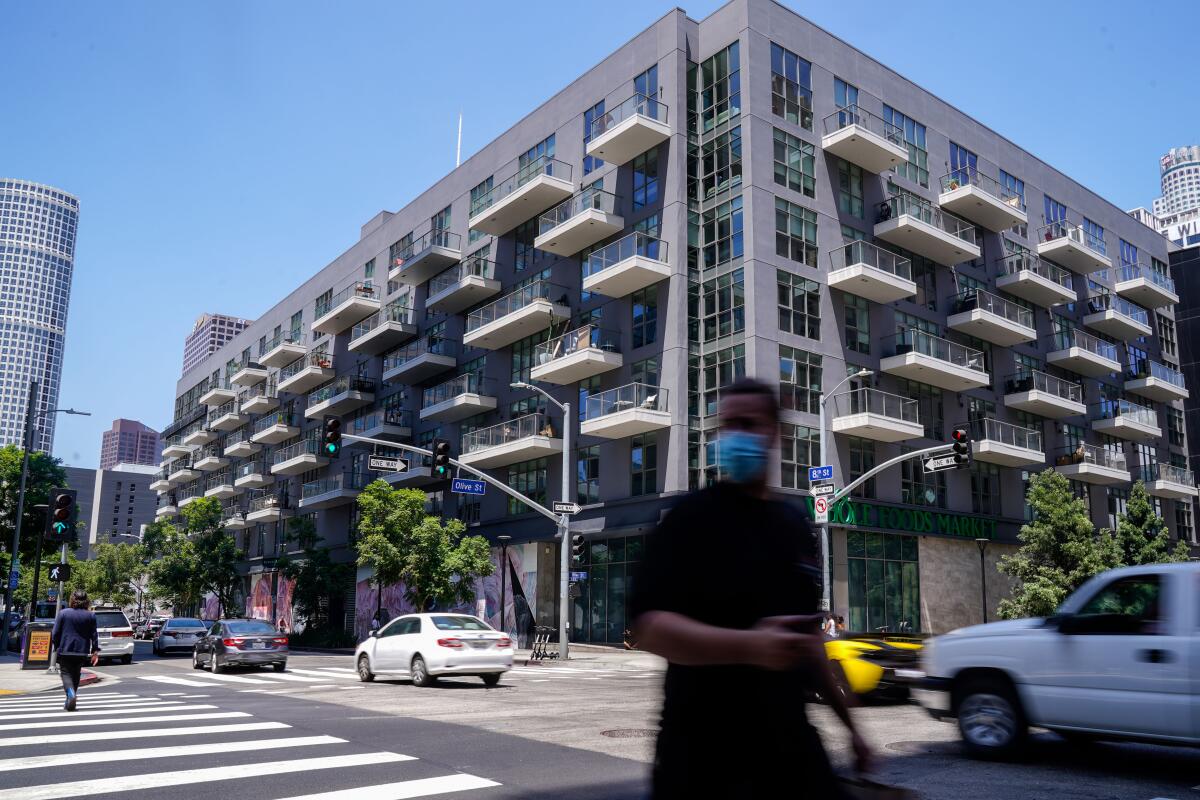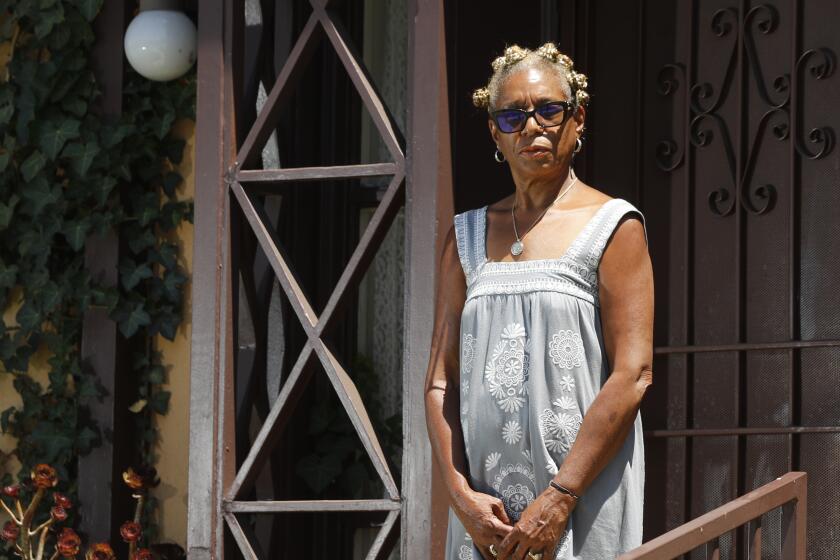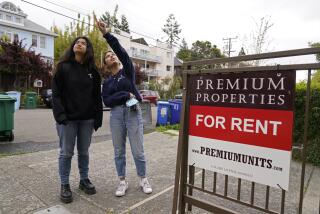L.A. rent is falling, with some big drops in luxury buildings

- Share via
The coronavirus economic downturn is bringing rents down in major cities across the country, including Los Angeles, as landlords seek to fill rising vacancies by trimming prices.
In downtown Los Angeles, rent for a 566-square-foot one-bedroom at the Eighth and Grand luxury apartments would have set you back at least $2,286 at the end of January, according to a listing on Zillow.
As of Thursday, the same size unit at the building with a Whole Foods on the ground floor was advertised for as low as $1,771.
A few blocks away, at another luxury building, monthly rent for the cheapest 1,284-square-foot, three-bedroom unit has come down $385, to $3,870. Walk a bit more and you’ll find more discounts, often with extra goodies such as two months’ free rent.
Interested? Tours, of course, will be virtual or self-guided.
The declines appear concentrated in the top end of the marketplace, according to multiple data sources, but there are signs rents are falling slightly on the lower end as well.
Data from real estate firm CoStar show the average asking rent as of Thursday for so-called Class A properties — think newer buildings with poolside cabanas, community rooms and a dog run — has fallen 4.3% in Los Angeles County from the beginning of March.
In Class B properties, which are often slightly more downbeat newer buildings or older, recently renovated properties, rents have dropped 2%.
Rents for Class C properties, usually the oldest buildings with the fewest bells and whistles in the apartment and in common areas, fell 0.2%.
RealPage, another provider, tracks rents slightly differently from CoStar but finds a similar trend in L.A. County: the sharpest declines toward the high end and the smallest toward the low end.
“The pain is landing at the top,” said Steve Basham, an analyst at CoStar.
It is common in recessions, industry analysts said, for rents at the higher end to fall further than rents for apartments marketed toward bus drivers, waiters and factory workers.
There are, after all, far more people able to afford a $1,400 one-bedroom unit compared with one priced at $2,600.
During an economic downturn, those paying $2,600 a month might also move to a less-expensive place, out of either necessity or a desire to save.
In addition, far more new apartments have been built in recent years on the high end, despite greater demand for lower-cost homes — a mismatch that’s so pronounced because high development costs usually make lower-cost homes a money loser, developers say.
Both of those dynamics are now creating greater vacancies in higher-end properties, Basham said, and putting heightened pressure on those landlords to bring rents down to fill vacant units that earn nothing.
Greg Willett, chief economist at RealPage, said rent declines in Class C buildings also tend to come later in a recession, and he expects larger drops to eventually hit the market segment during this downturn as well, even if declines may not reach levels new buildings will see.
John Pawlowski, an analyst at research firm Green Street Advisors, said some coronavirus-specific factors are quickening rent declines for expensive apartments in urban areas.
Developers have been able to command sky-high rents in part because they’ve persuaded people to pay more to enjoy added perks such as dog runs, poolside barbecues and club rooms. Now, some of those shared spaces are closed, and other reasons people might pay top dollar to live in a city — plentiful bars, restaurants and sporting events, for example — are also shut down or operating at minimal capacity.
“There is no good reason to sign a luxury lease right now in a city,” Pawlowski said.
That could be why CoStar data show the largest rent declines in the Mid-Wilshire area and downtown, where rents have fallen 10% and 8%, respectively, since March.
Those areas, which are more expensive than the city as a whole, have also seen a flood of new, luxury apartments as developers cater to young professionals attracted to nearby nightlife and other amenities.
Rents in more affordable markets such as southeast L.A. and Panorama City are essentially flat, according to CoStar data. Even in downtown and Mid-Wilshire, the declines are focused in the pricier buildings, with Class C rents down less.
Black Americans struggled with unaffordable housing before the coronavirus crisis and now face heightened risk of homelessness as the economy turns.
Rent data have limitations because, unlike home prices, the price a tenant pays is not public record and data from different companies reflect differing survey methodologies.
Zillow economist Joshua Clark said an analysis of his company’s data finds evidence that low- and high-priced neighborhoods are seeing similar rent declines, while the middle-of-the-road areas have seen slightly smaller drop-offs.
He attributed the differences to well-paid people cutting back on luxuries they can do without, as well as job losses that have hammered typically low-wage industries such as hospitality and retail.
Some landlords say they are seeing evidence of that trend as well.
Pacific Crest Real Estate owns more than 500 units, split between central Los Angeles and the San Fernando Valley.
Daniel Tenenbaum, the company’s founding principal, said he’s cut rent about 4% to 6% at his older Koreatown properties for a simple reason: Young service workers are increasingly leaving the studios and one-bedrooms to move home.
“They were some of the first people to have suffered,” he said, citing job losses.
By comparison, fewer people have moved out of his San Fernando Valley properties with larger units rented to families with middle-class jobs. There, he said, he’s trimmed rent by about 2% to 3%.
“If we have higher vacancy, we lower the rents more,” he said.
Enhanced unemployment benefits have kept rents steadier than they might have otherwise been, experts said, particularly on the lower end of the market where tenants are more likely to work in retail or hospitality.
Under the CARES Act stimulus legislation passed by Congress and signed into law by President Trump, the federal government boosted unemployment checks by $600 a week, enabling many renters to keep paying. But that backstop expired at the end of July and Congress has yet to pass a replacement.
Expanded federal jobless benefits and an eviction moratorium have expired. And the biggest state protection against evictions could go away this month.
On Saturday, Trump signed a memorandum that seeks to provide unemployed Americans an additional $400 a week, down from $600, through a program that would tap federal disaster relief funds and require states to opt in and pick up 25% of the tab.
Given its nature, there are questions not only about how quickly the money could go out and how long it would last, but also whether it’s legal because the power to spend money generally rests with Congress.
If new help doesn’t arrive, rents could decline even more on the low end, but it may come as the result of economic and personal devastation.
A statewide pause on most evictions could end as soon as Friday, leaving households to navigate a maze of local eviction restrictions that tenant advocates say are too weak.
Studies have found people who are evicted are more likely to become depressed, experience symptoms of post-traumatic stress disorder and die of any cause.
The UCLA Luskin Institute on Inequality and Democracy estimated in May that if the statewide eviction pause ended, roughly 365,000 L.A. County households would be at great risk of being evicted and 36,000 to 120,000 of those households would be likely to end up homeless for at least some time.
Those estimates didn’t take into account the expiration of the $600 in additional weekly unemployment benefits.
“It could be a pretty dramatic downturn in the coming months,” CoStar analyst Basham said.
Trump on Saturday also signed an executive order that directs his administration to find ways to prevent evictions, but again it’s unclear what can be accomplished if the executive branch acts on its own.
More to Read
Sign up for Essential California
The most important California stories and recommendations in your inbox every morning.
You may occasionally receive promotional content from the Los Angeles Times.









